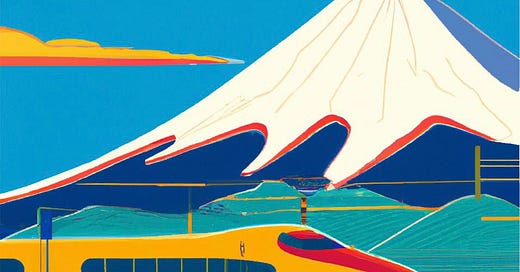If my native north east is where railway engineering germinated, then Asia is where it is blossoming. The Japanese bullet train - or shinkansen (新幹線 - new trunk line) - is a marvel of engineering, I’ve no doubt, but it is its status in the national psyche that I most admire.
A crisp morning in the autumn of 1964: the sleek Tōkaidō Shinkansen pressed forward its prow on its first journey from Tokyo to Osaka, following the ancient route between the two cities, just in time for the opening of the Tokyo Olympics. Ancient games, ancient road, future tech. This extraordinary railway reduced the travel time between two of Japan’s largest cities from six hours and forty minutes to an astonishing three hours and ten minutes. Less than twenty years after Hiroshima and Nagasaki, Japan was back.
That, I think, is how the Japanese view their trains: evidence of national strength; proof of renewal, and the shinks are the phoenix’s feathers. Some things apply to all Japanese trains: absurdly clean, absurdly punctual, reliable. But the shinkansen are special and are treated accordingly. You get a special ticket, there are special gates in the train station that take you shink-side. The trains have sleek names: nozomi (hope); hikari (sunray); kodama (echo). The trains themselves, like speedy bottle-nosed dolphins, are spectacles.
Now bullet trains ( 弾丸列車 dangan ressha - the name attached to the prototype when the shink was first mooted in the 30s) form the pipework of the three largest islands in the archipelago, with swooping viaducts, mighty bridges, gleaming stations.
They’re pricey. When I was a student living in Japan, we couldn’t afford a shink ticket. Only foreign tourists are able to get the wonderful JR Rail Pass (permitting unlimited travel on all Japan Rail trains except the speediest shinks, the nozomi) and so, since we had Japanese residence stamps in our passports, they were denied to us then. Instead, we were able to get something called a seishun jūhachi kippu (something like “youthful eighteen" ticket, but literally “blue spring eighteen”), which meant we had to crawl our way up to Tokyo from Fukuoka from end to end on local trains.
No longer! Every time I’ve been back to Japan since, we’ve lorded it about on the shinks: they are smooth as cream, but the blurred view of green and concrete gives you the speed. Pretty young women deliver beer and snacks from a trolley. You can recline, even smoke in the right car. But before you’ve slurped your last lick of Asahi superdry, you’re pulling in to Shin-Osaka and ready for another.
This Things I Love is timely since Nav and I are heading out east at the beginning of April. Snacking on the traditional eki-ben (“train station packed lunch”: oddly, Japanese train stations often have some of the best restaurants and you can always get a reliably good packed lunch), we will leave the cherry blossoms in our 200mph dust, tickling Mt. Fuji’s toes.
They outclass British railways in all respects: I choose not to dwell on that too much.
Bullet trains. I love bullet trains.






